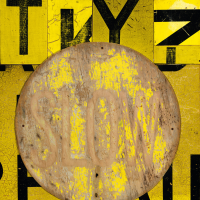20. ROSALIE GASCOIGNE

Your art has to come out of your daily life. I really believe that if anyone is born an artist theyve only got to look at whats around their feet and whats available to them. They dont have to be clever, they dont have to go to art school, they dont have to get the exotic stuff in make it with whats there. People think that arts like you strike it lucky and youre famous tomorrow, but it isnt like that, its a search for honesty on your own terms. The journey to self-recognition took me decades.1
Rosalie Gascoigne occupies a particular place in contemporary Australian art. Her contribution is unique for the beauty of the works she produced as it is for the materials she used. Gascoigne looked to the everyday and found objects as her source. The choice of materials may seem idiosyncratic and their value negligible, but Gascoigne chose instinctively. When asked about her choices she simply replied that she collected things because she liked how they looked.
The bricoleurs approach leaves much to taste and to aesthetics. There was an excitement for Gascoigne in finding and adapting fundamental non-art materials to her use. It shows a quotidian approach to value and a well thought tilt at taste. Gascoigne was pragmatic, but intuitive, in her grasp of any material, and how it could form an image.
Materials for Gascoigne became a lifes pursuit. To transform found materials into art demands structure, and Gascoigne chose to work in units giving continuity to an idea or insight to new forms. The cutting and shaping would then begin. Working flat, Gascoigne ordered her forms, thinking about surfaces and spacing her image edge to edge.
The current lot, Pink on Blue 1982-83 is similarly made from found material and was for Gascoigne a discovery: Another thing I get turned on by is building sites where there is pink wood undercoat pink on discarded scraps of timber and I was collecting a lot of pink wood. The background is made of Crystal boxes.2 In thinking about the formal massing of the pink sticks against the blue crystal background, Gascoigne came to her title by association. She thought of skinny-dipping and the sticks as the pink - skinned figures, with their arms clasped tightly to their sides as they entered the cold water. Crystal becomes cry, the delighted scream of the bathers.
For Gascoigne, the evocation was sustaining and the poetic interplay of image typical of the artists thinking. Amber 1992, the other Rosalie Gascoigne of our sale also plays to the association of word and image. Here the subtle configuration of circle to grid anchors a composition that is made from road signs. Gascoigne first gathered road signs in 1995 from Collector, near Canberra. Initially the artist thought road signs were pretty hideous when you saw them in the flesh, but she kept some out in the courtyard and one day the rain washed down and they came up a glory. She saw them differently, as organic. I dont want it to be dramatically lit, but I do want it to sometimes flash at you, as road signs do, and then go sullen, then flash, like a living thing.3
Amber is built upon a grid, and like many Gascoigne compositions, is the result of working in parts, trimmed, and squared flatly, before a final composition is achieved. The upper sections of Amber retain something of the original glint and hit of their colour but the weathered surface of the lower two thirds and the circle record time, and pull us in the direction of wind and rain. Slow is an echo, a reversal of where we were, at speed on the road, until we slow and fade. In memory at least, each kilometre marked by Gascoigne in her construction.
Building is a close analogy for the art of Rosalie Gascoigne, but road and landscape and the built environment are her domain. It is a simplicity of means and imagery that startles us in the work of Rosalie Gascoigne. Poetry is an economy found less so in art but essential to understanding Rosalie Gascoignes Pink on Blue and Amber. Each is different, but thought of similarly, are images that play on association. Amber for slow; pink figures against blue water. These are the essence and the great beauty of her art.
Footnotes
1. Rosalie Gascoigne, quoted in MacDonald, V., Rosalie Gascoigne, Regaro, Sydney, 1998, p.9
2. Rosalie Gascoigne, quoted in Gascoigne, M., Rosalie Gascoigne: A Catalogue Raisonn, Australian National University Press, Canberra, 2019, p.210
3. Ibid., p.123
Brett Ballard